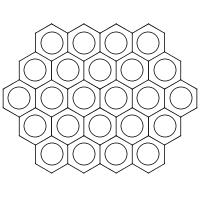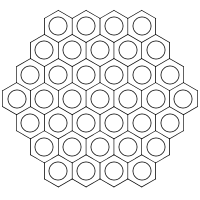I came across these “circumnames” quite by chance: several compounds were mentioned in this paper and some other can be found in this astrochemistry database. Is there any elegant way to name them systematically?

(a) circumpyrene | 
(b) ovalene | 
(c) pyrene |
For instance, ACD/Name gives the molecule (a) a systematic name dinaphtho[2,1,8,7-hijk:2',1',8',7'-stuv]ovalene, i.e. two naphtho groups are fused to the top and bottom of the ovalene (b) molecule, while the non-systematic name “circumpyrene” means that pyrene (c) core is completely encircled by fused benzene rings. Unfortunately, I was unable to generate ACD/Names for bigger molecules, such as circumcoronene (d) [i.e. coronene (e) encircled by fused benzene rings] and circumovalene (f). Apparently, ACD/Name cannot name compounds with more than 15 fused rings.

(d) circumcoronene | 
(e) coronene | 
(f) circumovalene |
If the “core” structure is surrounded by two rows of fused benzene rings, the doubly “circum” names like circumcircumpyrene (g) and circumcircumcoronene (h) appear.

(g) circumcircumpyrene | 
(h) circumcircumcoronene |



![cucurbit[5]uril in 2-D](https://blogger.googleusercontent.com/img/b/R29vZ2xl/AVvXsEhF_zooveg3Vfwtpfxr4sfSXXg1-TqdnTD-j3G75LGInJaziD58oL0XlfJuC63jCpyD_vm7FbdWCo8agKel1t2mNgTrSj_bFiqBotADutklgrOKXE-KcDYPojT-LpeThCWbTZUgMw/s320/cucurbit%5B5%5Duril-2D.png)
![cucurbit[5]uril in 3-D](https://blogger.googleusercontent.com/img/b/R29vZ2xl/AVvXsEjIfBuWDi5fT6E-U7JODCmq-dwf7sx8CzWHr4IWT2U-BuEZ6PLwChWXoPW7KehumKkIsK_5aZt5Y2iLoGxNmYsAbyJkLABBouabbm_UBDanggx-3YKQEyeD3EEV-tqU5Zpa1LGohw/s320/cucurbit%5B5%5Duril-3D.png)


![cucurbit[7]uril-oxaliplatin complex](https://blogger.googleusercontent.com/img/b/R29vZ2xl/AVvXsEiSI96JJB5n-xtRFjLkLiUIU9nvo52rlQCCu1RDNPB2UuLkG3IEO2ui-1UiWJfendsPtA8JPBoNvlWkYfcLgNv_7RKmlgQ87KvqYcPLqOw4GG8BRO5w2NUI7uppvUwkGZgJE_Bh6w/s320/cucurbit%5B7%5Duril-oxaliplatin-3D.png)














